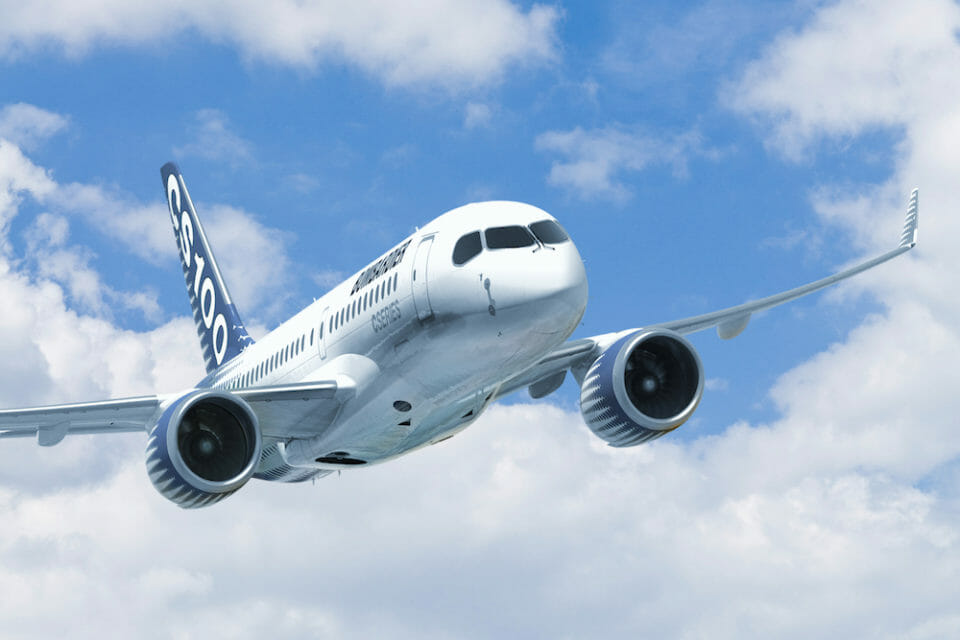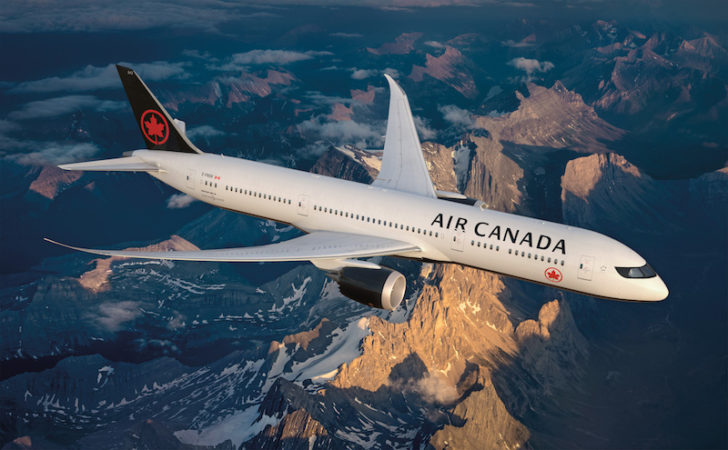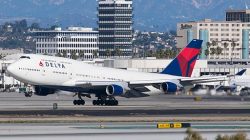It was another profitable, yet drama-filled year for airlines in 2017. While passenger demand soared in virtually every region of the world, and industry average load factors rose year-over-year, there was still plenty of stories to keep us entertained, excited, and inspired. Furthermore, there will be tons of fascinating stories to look forward to in 2018.
Here are my top 20 noteworthy aviation news stories that captured our hearts, minds, and thoughts in 2017.
Airbus’ Mic-drop Against Boeing to Buy the Bombardier CSeries Program
After the U.S. Department of Commerce proposed a tariff of over 200% on any Bombardier CSeries aircraft imported into the U.S., the message could be summed up in two words: Trade Wars.
Boeing has not produced an aircraft prototype for the sub-100 seat market since 2006 and is fearful that the CSeries will eat into some of its global market share in the future, despite the fact that Boeing’s global percentage is forecasted to grow from 38% in 2016 to 40% by 2025. Boeing has been in cahoots with the Trump Administration since shortly after the November 2016 election to squash any chances of Bombardier’s success in selling the CSeries in the U.S., and alleged that the CSeries had received billions worth of “unfair” loans and subsidies from Canada and the United Kingdom, even though Boeing has received plenty of its own bailouts from the U.S. government in the past.
So, Airbus decided to take a 50.01% stake in the C Series, with final assemblies to be completed at its Mobile, Alabama plant. This would, in turn, avoid the tariff since the production will take place on U.S. soil.

Collapse of Monarch and Air Berlin
In October, two European airlines ceased operations. Monarch U.K. entered administration on the 2nd and discontinued flights that very day. Air Berlin, which had filed for insolvency in German courts on August 15, 2017, slowly discontinued its long-haul operations in September 2017 and ceased short-haul flights in late October 2017.
Alitalia, which filed for insolvency as well in early 2017, is still flying, although it appears that nobody really wants to buy it.
Retirements of the 747-400 by both United and Delta
The #UA747Farewell received much fanfare by aviation geeks around the world. The last scheduled flight left San Francisco for Honolulu on November 7, 2017, with the fly-by of downtown San Francisco and the Golden Gate bridge. There were some operational issues that delayed the flight by an hour, but thankfully, everything worked out okay in the end.
Sadly, the same could not be said about Delta’s 747 farewells, which was scheduled to depart Detroit for Seoul Incheon on Sunday, December 17, but this was canceled due to the inability to fully staff the airplane with four required pilots. The flight was then re-scheduled for Monday, December 18 as an extra section. There was, however, a cool farewell tour that Delta held for employees and customers at its various hangars in ATL, SEA, MSP, and DTW. It did a cool flyby of MSP airport that is worth watching on YouTube.
Delta also launched its first revenue Airbus A350 routes, featuring its new First Class suites and true Premium Economy cabin, and the aircraft is currently flying between Detroit and Beijing, Seoul, and Tokyo Narita. Next year, it will also fly from DTW to Shanghai and Amsterdam.

Southwest Airlines Swaps out 737 Classics and Receives 737-MAX
On the same weekend, Southwest Airlines retired its 737-300 series aircraft and received its first 737-MAX aircraft. The MAX purportedly will be the plane that it will use to fly to Hawaii once it receives all of the required ETOPS certifications to operate overwater routes to the Islands. Southwest originally scheduled its first revenue flights on the MAX to operate the original triangle between Dallas, Houston, and San Antonio, although it encountered some issues before the second leg of the journey to San Antonio and the flight was subsequently canceled. Passengers did, however, receive refunds and vouchers.
Transatlantic Low-Cost Carrier Growth like WOAH
Speaking of the MAX, the first actual operator of the aircraft was Norwegian Air International, which launched service from several Northeast U.S. cities to Europe (Cork, Belfast, Shannon, Bergen, Dublin, and Edinburgh) from various U.S. ports (Newburgh/Stewart, Providence, and Hartford. LEVEL started flights from Barcelona to Oakland, Los Angeles, Buenos Aires, and Punta Cana. Icelandair launched Philadephia and Tampa, and WOW Air started Miami, Chicago O’Hare, and Pittsburgh. WestJet also added a plethora of routes on its 767s to London Gatwick as well.
All of this growth prompted Delta to extend its Basic Economy product across the Atlantic as well, and whereas previously luggage fees were bundled with the fare on transatlantic flights, it will now come with an additional charge of $60 for the first bag and $100 for the second bag, in each direction.
WestJet Ordered 787s and is launching a ULCC
WestJet ordered 10 787-9s, which will enable it to grow operations to Asia/Pacific, Australia, and other markets in Europe beyond London. It also will launch a new ultra-low-cost carrier called, “Swoop” that will come on a few of its older 737-800s, and feature densified cabins and additional charges for ancillary services.
WestJet also announced a new joint venture partnership with Delta, which may have been one of the world’s worst kept secrets in airlinelandia.
Partnerships Galore
Airlines are getting into bed with frenemies to the degree that few of the new, “partnerships” are shocking to anyone anymore. Lufthansa and Etihad started a codeshare agreement on flights from Frankfurt to Latin America (on Lufthansa metal) and from Frankfurt and Munich to Abu Dhabi (on Etihad metal). American purchased a very small equity stake in SkyTeam’s China Southern Airlines, which has now developed into a codeshare agreement, and AA also rebuffed Qatar Airways offer to purchase a 10% stake in American. Qatar has, however, purchased a small stake in Cathay Pacific, which is rumored to leave oneworld (though few credible sources seem to admit this will actually happen). United hopes to get a JV approval with Avianca.
Trump Travel Ban
First came the January 27 executive order that banned entry for 90 days by citizens from Muslim-majority countries including Iraq, Syria, Iran, Libya, Somalia, Sudan, and Yemen. It was subsequently blocked. In March, the Department of Homeland Security announced a decision to ban carry-on laptops and tablets on direct flights from eight Muslim-majority countries including Egypt, Jordan, Qatar, Kuwait, Morocco, the United Arab Emirates, Saudi Arabia, and Turkey. The United Kingdom implemented similar measures.
The Middle East Freeze-Out of Qatar
A total of 9 nations agreed to sever ties with Qatar, including Saudi Arabia, the United Arab Emirates, Egypt, Bahrain, Mauritius, the Maldives, Libya, and Yemen. This meant that Saudi Arabia halted all land, sea, and air links with Qatar, and the UAE closed its airports and harbors to Qatari Flights. Emirates, Etihad, FlyDubai, and Gulf Air all canceled flights to Doha, and Qatar Airways canceled all flights to Saudi Arabia.
Delta Cried Foul Against the Gulf Carriers. Trump Plans to Do Nothing.
Delta created a high-definition video criticizing the business practices of the Middle East carriers. It was actually a very well-produced video with a lot of cool, #AvGeek-related footage. But that was about it in terms of actual redeeming factors about the video. Not that I’m a fan of all of the Gulf carriers’ business practices, but I’m definitely not a fan of hypocrisy. You can read more about my take on the video here.
The other interesting news? The Trump Administration has decided not to revisit the Open Skies agreement between the U.S. and Qatar/UAE and doesn’t plan to punish the Middle East carriers. Smart move, these airlines contribute billions of dollars to the U.S. economy. Silly rhetoric must come to an end.
That Said, the ME3 Still Suffered
Qatar Airways suffered from both the laptop ban AND the closed airspace/freeze-out situation. Emirates was forced to cut capacity by 20% to the U.S., although it is slowly resuming daily frequencies to affected markets one-by-one.
The carrier that probably is suffering the most appears to be Etihad, which already had the smallest network of the three in the U.S., and is also the smallest by total global seat capacity. It also has made some particularly poor investments in debt-ridden, highly-unprofitable flag carriers like Alitalia, Virgin Australia, Darwin Airlines, and Air Berlin (now shut for good). Etihad also lost an interline/codeshare agreement with American Airlines this year and will pull the plug on its Dallas/Ft. Worth-Abu Dhabi route in February. Etihad also dropped flights to San Francisco and Sao Paulo in 2017.
And There Were Executive Shake-Ups, Too
Speaking of Etihad, its former CEO James Hogan stepped down this year, with some speculation that the “radial alliances” strategy of investing in poorly-run carriers was largely his idea, and things weren’t going to plan. In the U.S., Spirit CEO Bob Fornaro and Hawaiian Airlines CEO Mark Dunkerley announced that they were stepping down and retiring from their positions, respectively, with Fornaro vacating his position to Ted Christie in 2019 and Dunkerley being replaced by Peter Ingram in March 2018.
Elsewhere, Malaysia Airlines turnaround CEO Peter Bellew abruptly resigned from the carrier towards the end of the year and announced he was returning to Ireland to help fix the mess that is Ryanair’s pilot shortage problem. On that note, many people seem to believe that Michael O’Leary’s days at Ryanair appear to be numbered?
Ryanair Cancellations Saga
Ryanair scrapped thousands of flights on dozens of routes between November 2017 and March 2018, affecting nearly 700,000 passengers who had booked tickets on these flights. The cancellations were the result of a crew scheduling error, with more pilots taking vacation time during the winter period than anticipated.
American Airlines nearly suffered a similar fate over the holiday period, but quickly managed to resolve the situation by offering pilots bonus pay, and subsequently, few, if any, flights were canceled.
Meltdowns After Meltdown
Delta suffered an IT meltdown in April 2017 that lasted for several days, while British Airways suffered one the following month which also wreaked havoc across the world. It’s never a good thing when some of the world’s largest airlines encounter technical outages at some of the world’s biggest hubs, like London Heathrow and Atlanta. Furthermore, Delta encountered yet another issue, thankfully lasting only one day, at its Hartsfield-Atlanta Jackson hub, which resulted in millions of dollars worth of cancelations and impacted many other carriers flying into ATL.
Delta CEO Ed Bastion largely blamed the recurrence of these issues on lack of IT expenditure during the post-9/11 era, as airlines were struggling to stay alive and could not make software infrastructure investments due to cost-cutting.
Rally in the Wake of the Storm
The series of storms which impacted the Southeast, Gulf Coast, Mexico, and the Caribbean uprooted millions of people and created billions worth of damage. However, thanks to the kindness of many, there were numerous people who rallied to, “care-lift” supplies into Puerto Rico. One example included Spirit Airlines’ “Care-Lift” to Puerto Rico, organized by Floridians Chris Sloan, his wife Karla, and Lara Richardson. There is still a GoFundMe page in honor of this incredible charitable effort.
There were also some incredible relief efforts organized for the victims of Hurricane Harvey, such as Southwest Airlines’ evacuation efforts of pets as part of its 737-Classic retirements, along with several others arranged by American, Delta, United, Frontier, JetBlue, and Alaska. Delta also flew into the eye of the storm – twice – as Hurricane Maria prepared to hit San Juan.
Air Canada is Creating a New FFP and Introducing a New Livery
Over a decade since its ProjectXM overhaul, where Air Canada traded in its green-and-red branding for an icy, winter-blue look, it has decided to go back to the green/black paint scheme and feature the red, encircled Maple Leaf flag on the tail. The black windows in the cockpit also seem to resemble a Canadian Goose, but hopefully, few bird strikes will actually take place here…

Air Canada also announced that it would create its own loyalty program in 2020, although it seems to be unclear about what it will do with Aeroplan, which is spun off in 2002.
Aer Lingus Opts out of OneWorld
The Irish carrier, now owned by International Airlines Group, has chosen not to re-join OneWorld, an alliance it left in 2007, but will be open to the concept of partnerships and joint venture agreements with other OneWorld members (read: transatlantic JBA between American and IAG) in the future. Which is really all American cares about in the end, right?
Air France-KLM, Delta, Virgin Atlantic, and China Eastern Deepen Partnerships
Virgin Atlantic officially became part of the joint venture agreement currently existing between Air France-KLM, Delta, and Alitalia on transatlantic flights. Furthermore, China Eastern and Delta are each taking a 10% stake in Air France-KLM, which is, in turn, taking a 31% stake in Virgin Atlantic.
The Internet Continued to be Unforgiving
Amid all of the drama between #LeggingsGate, #BumpGate, #AnnCoulterTwitterBreakdownGate, strollers hitting babies and the NAACP issuing a travel advisory for Black Americans choosing to fly on American Airlines, and so on, the double-edged sword that is social media and the viral internet continues to play an oft-complicit role in spreading sensationalism and “alternative facts” for the sake of getting hits, likes, clicks, troll-bait, etc.
Let’s all try to be a bit more level-headed next year and wait for the “actual facts” to appear before we take sides, issue words, harass, bully, etc. Wishful thinking, though, I know.
And Finally, Someone Boarded the Wrong Plane? Chrissy Teigen Had a Field Day
Welp. Either someone REALLY did not want to fly on United Airlines or just happened to stumble their way onto an All Nippon Airways flight from LAX to Tokyo, and the flight was forced to turnaround and head back to LAX when it was four hours into the trip to Tokyo.
I guess the ANA flight wasn’t in the fast lane from L.A. to Tokyo?
Supermodel Chrissy Teigen supposedly garnered attention for a hilarious series of Tweets she sent out, as she was seated in First Class on this particular flight. Sucks that she’s preggers, though. Even in first, I can’t imagine that is very much fun to endure.


